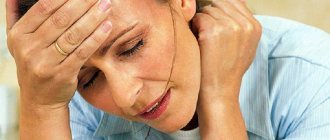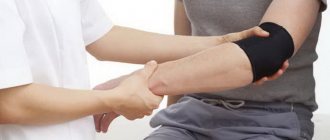Estrogens and progesterone play a key role in regulating the menstrual cycle and pregnancy, but they also cause headaches during menstruation.
A stable, high level of estrogen improves well-being and reduces the frequency of headaches, while low estrogen levels and its fluctuations throughout the cycle increase it.
A drop in estrogen concentration before menstruation can cause headaches.
There is also the concept of “menstrual migraine”. It is characterized by the occurrence of typical migraine attacks before or during menstruation and requires a special approach to treatment.
Headache before menstruation
Headaches during menstruation can be considered as a component of premenstrual syndrome (PMS), which affects almost half of all women.
This condition is characterized by the appearance of unpleasant symptoms a few days before the onset of menstruation. They disappear with the arrival of periods.
At the moment, it is not accepted in medicine to consider PMS as a result of hormonal imbalance.
On the contrary, it has been proven that premenstrual syndrome is observed in women with a regular cycle, in which all phases are clearly visible, while in patients with disorders (anovulation, amenorrhea, long delays) no changes occur.
Interesting! During pregnancy, when the concentrations of progesterone and estrogen are constantly high and stable, such signs are not observed!
In addition to behavioral abnormalities, increased appetite, fluid retention, autonomic reactions, abdominal pain, cephalgia (headache) comes to the fore in some women.
It is usually bilateral, localized in the frontoparietal region, and sometimes resembles a “helmet”. Patients describe it as a feeling of pressure, heaviness; They, as a rule, do not feel sick or vomit.
Treatment of migraines during menstruation
The causes and treatment of headaches during menstruation are inextricably linked. First, the specialist conducts a full examination of the patient, including a gynecological examination, ultrasound of the pelvic organs, X-ray and endoscopic techniques. According to indications, the gynecologist prescribes consultations with other doctors. The complex scheme includes physiotherapeutic, traditional and medicinal methods.
Treatment of headaches during menstruation with folk remedies
Soothing herbal teas prepared from valerian, chamomile, mint, and yarrow have a good effect. For the recipe you need to take 1 tbsp. l. one herb or mixture in equal proportions, pour 0.5 liters of water, boil for 5 minutes. The cooled and strained broth is taken 100 ml three times a day.
If a woman has a headache and does not have her period on time, she should not self-medicate. There is a possibility of pregnancy or exacerbation of gynecological diseases, so you should immediately go to the doctor.
Cold therapy
To remove vasodilatation and relieve swelling, you can apply a compress of ice cubes or frozen foods wrapped in cloth to your forehead. A less aggressive option is to wet a towel with cool water and apply it to your head. This compress is kept for 30–60 minutes, renewed as it warms up.
Treatment of headaches with cold is contraindicated for elevated body temperature and gynecological diseases!
Application of essential oils
Pleasant aromas have a beneficial effect on a woman’s psycho-emotional state, help her relax, relieve nervousness and irritability. Healing oils improve the delivery of oxygen to the brain and have a general strengthening effect.
To relieve headaches before menstruation, extracts of rosemary, lemon balm, lavender, and orange are used. To quickly spread the smell, you should use an aroma lamp. If it is not there, you can drop the oil into a container of hot water or spray it in the air.
Classic head massage
Impact on acupuncture points improves blood circulation, relieves spasms, and has a relaxing effect. You can perform the procedure at home yourself or ask someone close to you, but it is better to contact an experienced massage therapist. The specialist will prescribe the optimal type of manual technique that will definitely not harm your health.
Treatment with drugs
Medicines are prescribed for intense pain that cannot be relieved by other means. The tablets are selected by the doctor; their independent use is fraught with adverse reactions. Depending on the cause of the ailment, the following remedies are used:
- Analgesics (NSAIDs). These include Citramon, Nurofen, Paracetamol, Metamizole sodium. The tablets help well with pain of moderate intensity; if the instructions are followed, they rarely cause undesirable consequences.
- Antispasmodics. To eliminate spastic pain, No-Shpa, Spazmalgon, and Papaverine are prescribed. Medicines relax the smooth muscles of blood vessels and improve blood circulation, so that discomfort disappears.
- Triptans. This group of drugs is used for migraines. They reduce unpleasant symptoms during an attack, and when used at the stage of initial manifestations, they can prevent paroxysm.
If the pain syndrome is caused by pathological hormonal fluctuations, the doctor prescribes contraceptives. Medicines improve a woman’s well-being and maintain the regularity of her cycle.
Menstrual migraine
Menstrual migraine is a special type of headache that occurs during menstruation against the background of a sharp decrease in the level of sex hormones (estradiol and progesterone). It is observed in half of women suffering from migraines.
According to the international classification, there are 2 forms of menstrual migraine:
- 1 True menstrual migraine (10-20%). It is characterized by the occurrence of attacks a couple of days before and in the first 3 days of menstruation in at least two out of three cycles. On other days of the cycle, pain does not occur.
- 2Migraine without aura associated with menstruation. It differs from the first form only in that attacks occur on other days of the cycle.
The main causes of such pain are a sharp drop in the level of sex hormones and an increase in the concentration of prostaglandins in the bloodstream before menstruation and in the first 2-3 days after their onset.
Interesting! It has been experimentally proven that the introduction of estrogen into a woman’s body immediately before menstruation delays the time of the next attack!
How does headache menstrual pain manifest?
Pain in the head is not always a companion to menstruation; it can overtake a woman after the end of monthly uterine bleeding, but almost always accompanies premenstrual tension syndrome. This period is characterized by a change in psycho-emotional and physical state, manifested by a sharp change in mood, increased irritability, and causeless tearfulness.
Paroxysmal throbbing pain in the temporal and occipital parts is called menstrual migraine. According to medical classification, two forms are distinguished:
- true (real), characterized by severe episodic pain 2 days before or 3 days after critical days and manifesting itself during 2-3 monthly stages;
- associated with menstruation, accompanied by severe pain attacks and manifested on the first day of menstruation, as well as during any other period.
Both forms of cephalgic syndrome have the following symptoms:
- concentration of pain in one part of the head;
- increased sweating;
- pale skin;
- high surges in blood and venous pressure;
- heart rhythm disturbances, tingling in the heart area;
- decreased visual acuity;
- nausea and dizziness.
Attacks can be aggravated by aching pain in the lower abdomen, painful swelling of the breasts, lower back pain and intestinal upset.
Associated symptoms of migraine before menstruation include:
- increased sensitivity to external stimuli (light, smell, sound);
- swelling of the face and limbs;
- vertigo;
- gagging;
- change in taste preferences;
- decreased/increased appetite;
- sleep disturbance;
- decreased performance;
- fatigue, weakness;
- unstable mood.
Typically, the pain subsides with the onset of bleeding. Pain that does not go away after menstruation signals a high hormonal concentration in the blood.
Difference from other headaches
This is a special pain, it has specific signs. We can talk about migraine if a woman has at least 5 attacks of this nature:
- 1The pain is one-sided.
- 2 Its character is pulsating, localization is often in the frontal, temporo-suciliary and parietal regions.
- 3The intensity can vary: from moderate to unbearable, and the duration of 1 attack is from 4 to 72 hours.
- 4 Associated symptoms: nausea, sensitivity to bright light, sound, stuffiness, smells, vomiting that does not bring relief, dizziness, various visual disturbances (flickering “flies”, flickering spots before the eyes).
- 5The headache gets worse with any physical activity, for example, walking up the stairs significantly increases the discomfort.
To make a diagnosis, at least two of these signs and a history of at least 5 seizures are required.
Menstrual migraine differs from ordinary migraine in its more severe course and high resistance to therapy.
Provoking factors
A number of factors increase the risk of seizures:
- 1 Taking oral contraceptives (COCs) . The content of estradiol in them gradually decreases, by the end of the cycle it is minimal in one tablet. On the one hand, this provokes the onset of uterine bleeding, and on the other, it causes menstrual migraine. The way out of this situation is to select another drug.
- 2 A state of emotional tension , stress, prolonged experiences, depression and other neurosis-like conditions can increase existing discomfort during menstruation and contribute to the appearance of pain.
- 3 Nutrition . As you know, some foods are triggers. These include chocolate, coffee, hard cheese, red wine, nuts, red meat. Taking them in large quantities before and during menstruation can negatively affect a woman’s well-being.
- 4 Existing vascular disorders during menstruation can provoke headaches due to changes in the tone of the arteries and veins, as well as fluid retention.
- 5 Chronic anemia . A low level of hemoglobin cannot fully supply the brain neurons with oxygen, which leads to brain hypoxia.
- 6 Meteor dependence . This phenomenon has been poorly studied, but some women experience headaches during rain, snowfall, or sudden changes in weather.
How to get rid of unpleasant symptoms
As a rule, women prefer to endure cephalgic syndrome without resorting to treatment. However, they are deeply mistaken in considering headaches to be a natural condition during menstruation. If you constantly have a headache during menstruation, you should consult a gynecologist and neurologist, who, after a thorough examination, will refer you for additional tests. Based on the results of medical diagnostics, specialists usually prescribe drug treatment, including:
- medications and vitamin complex;
- oral contraceptives and hormone blockers;
- adherence to daily routine;
- balanced diet;
- reasonable combination of work and rest;
- daily air baths.
For therapy to be effective, it is necessary to establish the relationship between menstruation and migraine. In this case, it is advised to keep a diary recording pain attacks and periods of critical days.
Getting rid of headaches during menstruation involves the use of various medications and folk methods:
- Elimination of menstrual migraine with the help of medications.
For mild pain, they resort to taking analgesics: aspirin, paracetamol. To prevent feeling unwell before menstruation, you need to take non-steroidal anti-inflammatory drugs 2-3 days before the onset of bleeding. Nurofen, ketorol, nifluril, peroxicam, nise and others are recommended. They help well with dysmenorrhea.
If the headache is severe, triptans - suma - or zolmitriptan are prescribed, which relieve the intensity of spasms and relieve associated symptoms (nausea, vomiting, increased photosensitivity).
If vomiting becomes more frequent or you feel dizzy during menstruation, use domperidone or cerucal.
If therapy aimed at relieving headache symptoms does not help, resort to treatment with hormonal drugs. They are taken starting 2 days before the attack and continue for up to 6 days. If there are contraindications, you should consult your doctor. According to indications, hormonal therapy is replaced by gluing special patches containing estrogen a week before menstruation.
- Aromatherapy.
Essential oils are an excellent sedative. Headaches before menstruation can be quickly relieved with rosemary and marjoram oil. Vascular spasms will be relieved by aromatizing the air with anise, chamomile or rose esters.
Aroma oils for headaches
If you often feel dizzy during menstruation, rubbing the temples or applying undiluted lavender oil to the back of your hand will help. Inhaling the oil, dripped onto a cloth or paper napkin, will eliminate pre-menstrual dizziness within a few minutes.
The ether of orange, spruce, mint and lemon balm will restore peace of mind and help you forget about insomnia before menstruation.
Due to their wide spectrum of action, aroma oils can be used for inhalation, rubbing through massage and bathing.
Aromatic mixtures of pine, mint and lemon, chamomile and lavender, ginger and mint have proven themselves to be effective in eliminating the signs of menstrual migraine.
Before using essential oils, you should do an allergy test.
- Traditional medicine is no less effective if you have a headache during or during menstruation.
The following recipes will help reduce premenstrual syndrome:
- strong tea (black or green) with the addition of mint, lemon balm and oregano will overcome weakness;
- infusion of cornflower flowers: 1 tbsp. l. plants are poured with 1 glass of boiling water, infused and after 2 hours drink a third of a glass of the strained solution before eating;
- Frequently drinking (every hour) chamomile tea or 30 drops of alcoholic infusion of valerian (3-4 times a day) will help cope with dizziness during menstruation.
- Following the principles of proper nutrition will help relieve symptoms that cause headaches during menstruation.
For this:
- include fish, soy, legumes and seafood in your diet;
- eat foods rich in vitamins C, E, calcium and magnesium;
- reduce the amount (especially before and during critical days) of products rich in sodium and salt;
- do not drink carbonated drinks;
- exclude sweet, starchy, salty and spicy foods from the menu;
- Don't overeat in the evening.
- Physiotherapeutic procedures: a complex of physical therapy, massage, acupuncture, hirudotherapy.
When there is a headache before menstruation, the main goals of drug and alternative therapy are to reduce the duration and frequency of the pain syndrome, eliminate the influence of cephalgia on the patient’s vital activity, and improve her functioning.
Diagnostic methods
Diagnosis is based on complaints and the typical picture of the disease. If the attacks meet the criteria described above, then additional diagnostic methods are not used.
Every woman is recommended to keep a diary where all headache attacks, accompanying symptoms, and connections with the cycle are recorded. This is necessary to select adequate therapy and control it. It is convenient to keep a diary in applications - women's calendars.
In case of intolerable attacks, their frequency, or the appearance of danger signals, an additional examination is carried out, including:
- 1Consultation with a neurologist, gynecologist-endocrinologist, therapist.
- 2 Ultrasound of the pelvic and abdominal organs, neck vessels and their Dopplerography.
- 3MRI, CT scan of the skull and brain, angiography of cerebral vessels.
Danger signals
The following signs should alert both the attending doctor and the woman herself, as they may be a manifestation of other life-threatening situations:
- 1 Thunderous, severe pain (usually sudden) occurs with hemorrhagic stroke, rupture of a cerebral artery aneurysm.
- 2 Pain that first appeared after age 50 , during pregnancy or after childbirth, as well as pain that has changed recently.
- 3 Progressive deterioration and intensification of attacks (metastases to the brain, growth of tumors).
- 4 The appearance of pain in women who previously had cancer.
- 5 Focal symptoms (paresis, paralysis, sensory disturbances), weakness, changes in consciousness, atypical aura, combination with prolonged fever.
- 6 Lack of effect from the treatment.
Any of these symptoms should be a reason for urgent additional examination of the woman.
How to treat?
Therapy for headaches during menstruation is based on three basic principles:
- 1Behavioral therapy, that is, lifestyle changes.
- 2 Direct elimination of the resulting attack of pain.
- 3Prevention of subsequent attacks (relevant for migraines).
7.1. Behavioral therapy
The doctor explains to the woman the cause of the headache and talks about the triggers. In the future, the patient can control her lifestyle, nutrition, work and rest schedule, and make notes in her diary.
It is necessary to give up bad habits and take large amounts of painkillers, which only aggravate the situation and lead to chronic pain.
7.2. Drugs
To reduce the intensity and duration of pain, you can drink one of the NSAIDs (non-steroidal anti-inflammatory drugs): Aspirin, Paracetamol, Nimesulide, Movalis, Ibuprofen, Diclofenac.
It is not recommended to take combination drugs containing caffeine, codeine, or barbiturates. Taking analgesics too often leads to more frequent attacks, this is called overuse pain.
For vomiting and nausea, you can use metoclopramide (Cerucal).
In case of a severe migraine attack, the doctor will prescribe triptans: sumatriptan (Amigrenin, Imigran), eletriptan (Relpax), naratriptan (Naramig), etc. The drugs are prescription drugs, so you cannot do without consulting a doctor.
Triptans are most effective when used at the very beginning of an attack. If they are insufficiently effective, they can be combined with NSAIDs.
Important! Triptans should not be used more than 9 days in one month; there should be a break of at least 2 hours between taking two doses. They are used only to relieve a migraine attack and are ineffective for other headaches!
7.3. Seizure prevention
Preventative treatment is usually used only for migraines. For the purpose of prevention, different groups of drugs are used. This is due to the fact that the causes and pathogenesis of the disease are not fully understood.
The doctor may prescribe:
- 1Beta blockers (metoprolol, propranolol, bisoprolol).
- 2 Anticonvulsants (valproate, topiramate).
- 3Antidepressants (amitriptyline, venlafaxine).
- 4Calcium channel blockers (verapamil), etc.
In conclusion, it is worth noting that both a gynecologist and a neurologist (if necessary, an endocrinologist) should treat headaches associated with menstruation.
It is necessary to take into account the intensity, duration and nature of pain, monitor dynamics and evaluate the effectiveness of therapy.
What pathologies can there be?
There are several factors why, when menstruation occurs, headaches bother women:
- vascular diseases;
- intestinal pathology;
- osteochondrosis;
- decrease in hemoglobin;
- hormonal imbalances.
During menstruation, in addition to cephalalgia of the brain, nausea, spots in the eyes and migraine may occur. The pain syndrome covers most of the head; lumbago may radiate to the ears and jaw area.
Unlike traditional localized migraine, migraine during menstruation is accompanied not only by headache, nausea, which can sometimes turn into vomiting, as well as throbbing piercing pain that is not affected by analgesics. The girl may be irritable, hostile, and have a feeling of fatigue that makes her want to lie down.
This exacerbation can last from ten hours to several days.
Also, migraine during the menstrual period can provoke disturbances in cardiovascular function, such as:
- atherosclerosis;
- vegetative-vascular dystonia;
Headache may occur due to hypertension
- arterial hypotension;
- compression of blood vessels.
The structure of blood vessels is affected by hormone surges, and the load on the arteries increases during the menstrual phase. Decreased elasticity of vascular walls, high levels of cholesterol in the blood - all this interferes with the normal functioning and movement of blood flow.
The blood arteries do not have time to straighten out, pumping blood in large volumes, and this is the cause of cramps - the beginning of headaches during menstruation. If there is a reduction in oxygen availability in the brain, the migraine takes on an antispasmodic nature.
Due to a failure of water-salt balance during the menstrual cycle, swelling occurs. Deterioration of water outflow can provoke weight gain - about one and a half kilograms. Edema forms on the face, upper and lower extremities, and even in certain areas of the brain. In the head, there is a bursting, squeezing pain in the area of the crown, back of the head and spreading throughout the entire part of the head.
Also, during menstruation, there is a possibility of severe pain due to taking certain medications, in particular, spasmodic syndromes are observed when taking oral contraceptives. It is noted that most women over the age of forty and girls with venous thrombosis suffer from headaches during menstruation.
From this video you will learn about the causes of headaches:
The pain syndrome appears because birth control pills cause hormonal deformation, which interferes with the maturation of the egg. Also in the female body, the formation of individual hormones is modified, and disturbances in vascular function are observed.











